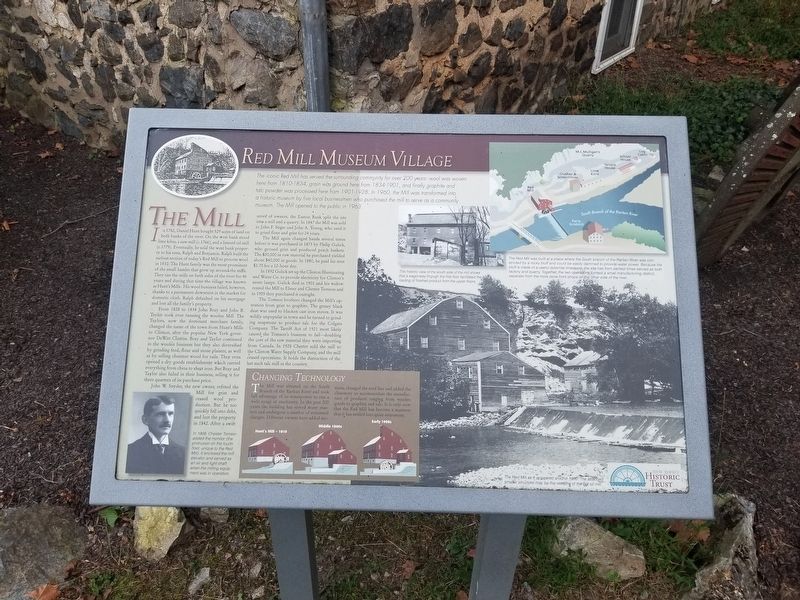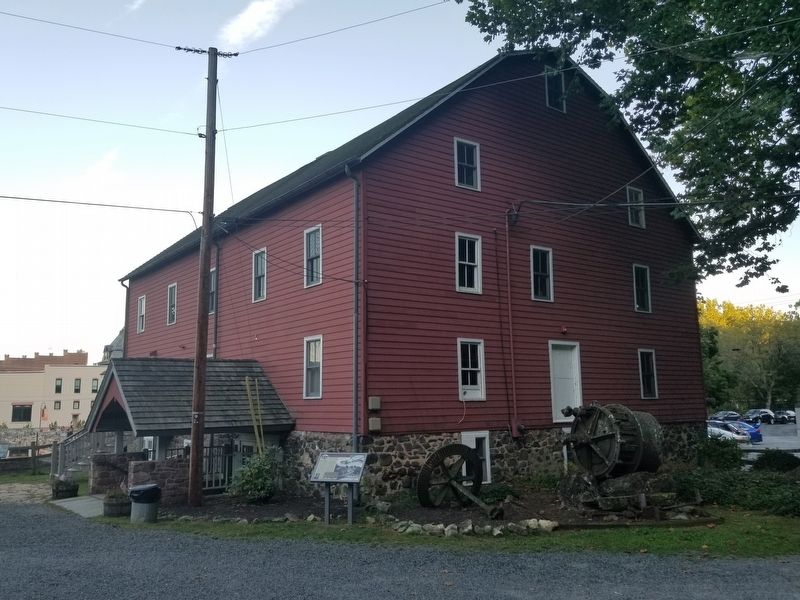Clinton in Hunterdon County, New Jersey — The American Northeast (Mid-Atlantic)
The Mill
Red Mill Museum Village
The iconic Red Mill has served the surrounding community for over 200 years: wool was woven here from 1810-1834, grain was ground here from 1834-1901, and finally graphite and talc powder was processed here from 1901-1928. In 1960, the Mill was transformed into a historic museum by five local businessmen who purchased the mill to serve as a community museum. The Mill opened to the public in 1963.
In 1782, Daniel Hunt bought 529 acres of land on both banks of the river. On the west bank stood lime kilns, a saw mill (c.1766), and a linseed oil mill (c.1779). Eventually, he sold the west bank property to his sons, Ralph and Benjamin. Ralph built the earliest section of today s Red Mill to process wool in 1810. The Hunt family was the most prominent of the small hamlet that grew up around the mills. They ran the mills on both sides of the river for 46 years and during that time the village was known as Hunt s Mills. His wool business failed, however, thanks to a permanent downturn in the market for domestic cloth. Ralph defaulted on his mortgage and lost all the family s property.
From 1828 to 1834 John Bray and John B. Taylor took over running the woolen Mill. The Taylors, now the dominant merchant family changed the name of the town from Hunt s Mills to Clinton, after the popular New York governor De Witt Clinton. Bray and Taylor continued in the woolen business but they also diversified by grinding feed, flour and stone plaister, as well as by selling chestnut wood for rails. They even opened a dry goods establishment which carried everything from china to sheet iron. But Bray and Taylor also failed in their business, selling it for three quarters of its purchase price.
John W. Snyder, the new owner, refitted the Mill for grist and ceased wool production. But he too quickly fell into debt, and lost the property in 1842. After a swift series of owners, the Easton Bank split the site into a mill and a quarry. In 1847 the Mill was sold to John F. Stiger and John A. Young, who used it to grind flour and grist for 24 years.
The Mill again changed hands several times before it was purchased in 1873 by Philip Gulick, who ground grist and produced peach baskets. The $30,000 in raw material he purchased yielded about $40,000 in goods. In 1880, he paid his men $1.70 for a 12-hour day.
In 1892 Gulick set up the Clinton Illuminating and Water Co. to provide electricity for Clinton s street lamps. Gulick died in 1901 and his widow rented the Mill to Elmer and Chester Tomson and in 1905 they purchased it outright.
The Tomson brothers changed the Mill s operation from grist to graphite. The greasy black dust was used to blacken cast iron stoves. It was wildly unpopular in town and he turned to grinding soapstone to produce talc for the Colgate Company. The Tarriff Act of 1921 most likely caused the Tomson s business to fail—doubling the cost of the raw material they were importing from Canada. In 1928 Chester sold the mill to the Clinton Water Supply Company, and the mill ceased operations. It holds the distinction of the last such talc mill in the country.
Changing Technology
The Mill was situated on the South Branch of the Raritan River and took full advantage of its waterpower to run a wide range of machinery. In the past 200 years the building has served many masters and undergone a number of structural changes. Different owners have added sections, changed the roof line and added the clearstory to accommodate the manufacture of products ranging from woolen goods to graphite and talc. It is only now that the Red Mill has become a museum that it has settled into quiet retirement.
( photo captions )
- In 1908, Chester Tomson added the monitor (the protrusion on the fourth floor, unique to the Red Mill). It enclosed the mill elevator and served as an air and light shaft when the milling equipment was in operation.
- This historic view of the south side of the mill shows that a wagonway through the first floor facilitated the loading of finished product from the upper floors.
- The Red Mill was built at a place where the South branch of the Raritan River was constricted by a rocky bluff and could be easily dammed to provide water power. Because the bluff is made of a useful dolomite limestone, the site has from earliest times served as both factory and quarry. Together, the two operations formed a small manufacturing district, separate from the more store front shops on the other side of the river.
- The Red Mill as it appeared around 1900. The attached smaller structure may be the remains of the old mill.
Topics. This historical marker is listed in this topic list: Industry & Commerce. A significant historical year for this entry is 1960.
Location. 40° 38.18′ N, 74° 54.778′ W. Marker is in Clinton, New Jersey, in Hunterdon County. Marker can be reached from the intersection of W. Main Street and Quarry Road, on the right when traveling west. Touch for map. Marker is in this post office area: Clinton NJ 08809, United States of America. Touch for directions.
Other nearby markers. At least 8 other markers are within walking distance of this marker. The Quarry (a few steps from this marker); The Mulligans (within shouting distance of this marker); Cornerstone, 1754 (within shouting distance of this marker); The Lime Kilns (within shouting distance of this marker); Hunterdon Historical Museum (within shouting distance of this marker); Red Mill Museum Village (within shouting distance of this marker); a different marker also named Red Mill Museum Village (within shouting distance of this marker); Dunham's Mill (about 300 feet away, measured in a direct line). Touch for a list and map of all markers in Clinton.
Also see . . . The Red Mill Museum Village. (Submitted on October 6, 2019, by Michael Herrick of Southbury, Connecticut.)
Credits. This page was last revised on October 6, 2019. It was originally submitted on October 6, 2019, by Michael Herrick of Southbury, Connecticut. This page has been viewed 255 times since then and 15 times this year. Photos: 1, 2. submitted on October 6, 2019, by Michael Herrick of Southbury, Connecticut.

